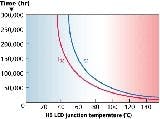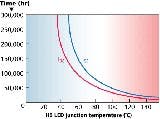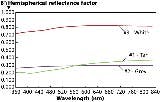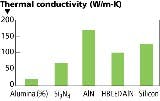Cost-reduced AlN delivers thermals needed in HB LED packages (MAGAZINE)
+++++
This article was published in the September 2013 issue of LEDs Magazine.
Visit the Table of Contents and view the E-zine version in your browser. You can download a PDF of the magazine from within the browser E-zine.
+++++
Excess heat leads to a whole range of performance and reliability issues for high-power semiconductor applications such as high-brightness LEDs (HB LEDs). The need for maximum heat extraction from the LED junctions has led to the use of aluminum nitride (AlN) ceramic packages in most high-power LEDs, whereas mid-power LEDs can utilize lower-cost alumina or even plastic packages. A cost-reduced approach to AlN, however, can deliver the thermal performance needed in HB LEDs while also delivering package costs more in line with mid-power devices. A reduction in HB LED package cost could help spur broader deployment of LEDs into solid-state lighting (SSL) applications.
The thermal management challenges in HB LEDs are simple to describe and hard to overcome. HB LED light output is sensitive to heat. As an LED gets too hot, more input energy is converted to heat instead of light, which further increases the LED temperature, leading to potential catastrophic failure. Fig. 1 shows the degradation of light output as a function of HB LED junction temperature. L70 refers to the point where the current light output of the LED is 70% of the original light output; at L50 the light output falls to 50%. This example illustrates clearly the critical importance of pulling heat away from the HB LED in order to ensure a low junction temperature and stable light output.
Role of packaging and materials
Conducting heat away from the semiconductor junction involves heat transfer in the z axis, as well as in the x and y axes. The z-direction thermal conduction happens directly from the diode junction heat source toward the heat sink. The x,y-direction conduction, or heat spreading, moves the heat horizontally away from the junction. The closer to the semiconductor junction, the more critical a role a material plays in thermal management. Thus, in order of importance, we can roughly rank device and packaging material thermal conductivity requirements:
- Semiconductor material below the junction (for non-flip-chip applications)
- Die attach material
- First level of packaging (conduction and heat spreading) — the substrate upon which the die is attached in the LED package
- TIM (thermal interface material) or solder between first level of packaging and board level
- Board-level packaging (conduction and heat spreading)
- TIM or solder between board and heat sink
- Heat sink or heat spreader
This simple discussion makes it very clear how critical the first level of packaging is to thermal management of high-power devices, which helps to explain the significant use of ceramic materials as a first-level packaging material for HB LEDs. Fig. 2 shows the basic packaging configuration for HB LEDs with a ceramic material as the first-level package. Fig. 3 shows a schematic of the packaged HB LED bonded to a metal-core printed circuit board (MCPCB) and heat sink, which illustrates the entire thermal path starting with the HB LED junction.
z axis." title="FIG. 2. The most direct thermal path through a packaged LED is from the diode junction through the package substrate on the z axis." border="0">
First-level packaging
We will focus on the first-level packaging options for the remainder of the article given the performance of the z-axis conduction. That first-level material is a primary component of the packaged LED and therefore contributes significantly to the cost of HB LEDs.
Let's begin by considering the two prominent options for substrates in LED packages. Alumina, or aluminum oxide (Al2O3), ceramics are widely used in lower-power LEDs. They deliver thermal conductivity of 20 W/m-K (watts per meter kelvin). In comparison, AlN delivers thermal conductivity of 170 W/m-K. If we consider both in a package that uses direct-plated copper technology, AlN has a cost factor greater than eight times that of alumina. Note we are not discussing the package cost but the cost of the ceramic component of the package.
AlN is an ideal choice for high-thermal-demand applications because of its combination of high thermal conductivity and mid-range coefficient of thermal expansion (CTE) of 4.5 ppm/°C. CTE is an important factor to ensure that electrical connections aren't damaged as temperature rises, causing component failure.
AlN is currently used in HB LED packaging but only in situations where there are no other feasible alternatives. The high cost pressure in the HB LED market, as well as the significant portion of total device cost that packaging entails, increases the need to minimize high-cost AlN usage.
The high cost of AlN substrates is attributable to a number of factors, with some of the most significant listed in Table 1. The causes span a range from high cost of raw materials such as AlN powder to complex and expensive manufacturing steps.
Reducing AlN ceramic costs
There are now options for materials, however, that fall between AlN and alumina that could change the HB LED cost equation. In fact, material scientists have developed a new AlN formulation that fits in the cost/performance gap between Al2O3 and conventional AlN. The main features of this new material — which CMC Laboratories refers to as HB-LED-grade AlN — are much lower powder and process costs, as well as thermal conductivity that falls between alumina and conventional AlN. Moreover, the new material has an inherently white color that is highly reflective in the human-visible range and is therefore conducive to usage in SSL products.
The new HB-LED AlN has a thermal conductivity of 100 W/m-K. That figure is five times higher than alumina, but 42% lower than conventional AlN. Still, the thermal performance is more than adequate for HB LED applications. The mechanical, electrical, and physical properties are very similar to conventional AlN.
One critical factor that drives lower substrate cost is that this new AlN material utilizes an AlN powder that is made by direct nitridation of aluminum metal. This powder typically costs 60–75% less than the traditional powder used in electronics applications, which is made through the carbo-thermal reduction of aluminum oxide.
Processing complexity
In addition, HB-LED AlN is processed at 1700–1725°C. In this temperature range, continuous furnaces are available that use alumina heat shields and molybdenum (Mo) heating elements. Though more complex and expensive than lower-temperature alumina sintering furnaces, from a cost and throughput standpoint, the equipment and process required to produce HB-LED AlN is less expensive and simpler than conventional AlN processing in high-temperature refractory metal or graphite batch furnaces.
This new material has the added benefit of being white in color compared with the tan color conventionally associated with AlN. This white color can be an advantage for optical applications, such as HB LEDs, because the reflection of visible light is much higher. This reflection data across the visible spectrum is shown in Fig. 4.
This figure shows reflectance factor plotted relative to wavelength for tan and grey conventional AlN ceramic samples and white HB-LED AlN. Note the HB-LED AlN reflects 70–80% through the visible spectrum, compared to about 30% for conventional material.
Table 2 contains more details about the properties of HB-LED AlN. The mechanical and electrical properties of HB-LED AlN are very similar to conventional higher-cost AlN ceramics, including flexural tensile strength measured in megapascals and indications of resistance to fracture, therefore directly impacting reliability.
Fig. 5 details the thermal performance of HB-LED AlN relative to other available ceramic packaging materials. The chart also includes undoped silicon for reference. The figures were obtained using laser flash analysis.
What is next?
CMC has applied for a patent to cover the technology described in this article and is now actively licensing this technology to interested manufacturers. CMC specializes in developing new materials for electronic interconnect and packaging applications.
The new AlN ceramic results in a material that from a cost/performance standpoint bridges the current wide gap between high-thermal-conductivity, high-cost AlN and lower-thermal-performance, lower-cost aluminum oxide. For the focused application of this technology, specifically in HB LED tiles, the 100W/m-K thermal performance is more than adequate. Due to the cost-competitive nature of these applications and the current high packaging costs for HB LED devices, there is a strong fit for a new material with a lower cost structure. As this material is adapted more widely, it is expected that it will compete for many applications that are now served exclusively by Al2O3.












